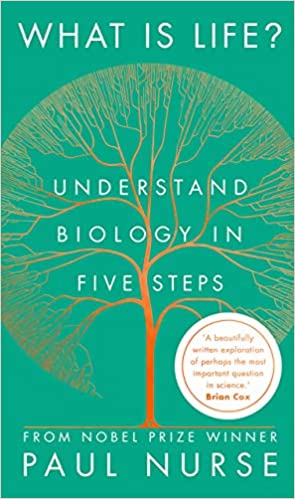 It may have been a butterfly that first started me thinking seriously about biology. It was early spring; I was perhaps twelve or thirteen years old and sitting in the garden when a quivering yellow butterfly flew over the fence. It turned, hovered and briefly settled—just long enough for me to notice the elaborate veins and spots on its wings. Then a shadow disturbed it and it took flight again, disappearing over the opposite fence. That intricate, perfectly formed butterfly made me think. It was both utterly different to me and yet somehow familiar too. Like me, it was so obviously alive: it could move, it could sense, it could respond, it seemed so full of purpose. I found myself wondering: what does it really mean to be alive? In short, what is life?
It may have been a butterfly that first started me thinking seriously about biology. It was early spring; I was perhaps twelve or thirteen years old and sitting in the garden when a quivering yellow butterfly flew over the fence. It turned, hovered and briefly settled—just long enough for me to notice the elaborate veins and spots on its wings. Then a shadow disturbed it and it took flight again, disappearing over the opposite fence. That intricate, perfectly formed butterfly made me think. It was both utterly different to me and yet somehow familiar too. Like me, it was so obviously alive: it could move, it could sense, it could respond, it seemed so full of purpose. I found myself wondering: what does it really mean to be alive? In short, what is life?
What is Life?: Understand Biology in Five Steps
by Paul Nurse
ポール・ナース(著)
竹内薫(訳)
https://diamond.jp/articles/-/264669
**
生命とは何か?
**
生命の樹(p.243)
このように、生き物には、全面的に他に依存するウイルスから、自給自足の生活を送るシアノバクテリアや古細菌や植物まで、境目のないグラデーションがある。こうした異なる形態はすべて生きている、と私は言いたい。すべての形態は、程度の差こそあれ、他の生き物に依存しつつ、自然淘汰で進化し、自らを律する物理的存在であることに変わりないからだ。
この広い視野に立って生命を眺めてみると、生物界に対する広々とした視界が開ける。地球上の生命は一つの生態系に属している。そこには、あらゆる生き物が組み込まれ、相互にあまねくつながっている。
このつながりは本質的なものだ。それは、相互依存の深さだけでなく、あらゆる生命が共通の進化のルーツを通して遺伝的に親戚であることによってもたらされる。
こうした深い関連性と相互のつながりという見方は、ずっと以前から生態学者が主張し続けてきたものだ。元をたどれば、一九世紀初めの探検家で博物学者アレクサンダー・フォン・フンボルトの考えに端を発している。
彼は「あらゆる生命は、全体がつながったクモの巣のようなもの」と主張した。思いがけないことかもしれないが、こうした相互のつながりこそが、生命の中核なのだ。だからこそ、人間の活動が他の生物界に与えてきた影響について、われわれは、立ち止まって、じっくり考えるべきなのだ。
生命が共有する家系図、生命の樹のたくさんの枝の生き物たちは、驚くほど多様だ。しかし、そんな「多様性」も、視点を変えれば、もっと本質的な「類似性」の前では光が失せる。化学的、物理的、および情報の機械として、その機能の基本的な細部は、みんな一緒だ。
たとえば、同じ小さなATP分子を「エネルギー貨幣」として利用し、同じく基本的なDNAとRNAとタンパク質のあいだをつなぐ関係に頼り、リボソームを使ってタンパク質を作る。
フランシス・クリックは、DNAからRNA、そしてタンパク質への情報の流れが、生命にとって非常に根本的なものだと主張し、それを分子生物学の「セントラルドグマ」と呼んだ。それ以来、このルールに従わない、小さな例外を指摘した人もいたが、クリックの要点は依然として破られていない。
**
物語のはじまり(p.245)
生命の化学的基礎におけるこうした深い共通性は、驚くべき結論を指し示している。なんと、今日地球上にある生命の始まりは「たった一回」だけだったのだ。もし異なる生命体が、それぞれ何回かにわたって別々に出現し、生き延びてきたとしたら、その全子孫が、これほどまで同じ基本機能で動いている可能性はきわめて低い。
あらゆる生命が、巨大な同じ生命の樹の一部だとすれば、その樹はどんな種類の種子から成長したのだろう? どういうわけか、どこかで、はるか昔に、無生物の無秩序な化学物質が、より秩序だった形態に自分を配置した。
自らを永続させ、自らをコピーし、最終的に自然淘汰によって進化するという、きわめて重要な能力を獲得したのだ。しかし、われわれも登場人物の一人である、この物語は、実際にはどのようにして始まったのだろう?
地球は四五億年ちょっと前、太陽系の黎明期に形成された。初めの五億年ほどは、この惑星の表面は熱すぎて不安定で、われわれが知るような生命は物理的、化学的に出現できなかった。
これまでに曖昧さを残さない形で特定された、最も古い生命体の化石は、三五億年前に生息していたものだ。生命が立ち上がって走り出すまで、数億年かかったわけだ。想像を絶する、悠久の時の広がりだが、地球上の生命の歴史から見れば、僅かな時間にすぎない。フランシス・クリックは、その時間内で、生命がこの地球で始まった可能性は非常に低いと考えた。
だから彼は、生命は宇宙のどこかで誕生し、(部分的にか完全に形成された状態かは別として)地球まで運ばれてきたにちがいないと示唆したのだ。しかし、彼は、生命がどのようにして慎ましい発端から始まったのか、という重要な疑問に答えるどころか、はぐらかしてしまっている。現在、われわれは、未だ検証できないにしても、この物語について信用できる説明をすることができる。
最も古い化石は、現在の細菌のいくつかに似ている。これは、その時点で生命がすでに、膜に包まれた細胞、DNAに基づく遺伝システム、タンパク質に基づく代謝作用などを備え、充分に確立されていたことを意味する。
しかし、どれが最初だったのだろう? DNAに基づく遺伝子の複製、タンパク質をベースにした代謝作用、それとも包み込む膜組織だろうか? 現在の生体では、これらは、相互に依存するシステムを形成し、まとまって初めて機能する。DNAに基づく遺伝子は、酵素タンパク質の助けを借りることでのみ、自らを複製することができる。
しかし、酵素タンパク質は、DNAが保持する命令によってしか作ることができない。どうすれば片方ぬきで、もう片方を手に入れることができるのか? さらに、遺伝子と代謝作用は、どちらも、必須の化学物質を集めたり、エネルギーを得たり、環境から自らを守るために、細胞の外膜に頼っている。
ところが、現在、生きている細胞は、遺伝子と酵素を使って自分たちの精緻な細胞膜を形成するのだ。遺伝子とタンパク質と細胞膜。このきわめて重要な三位一体の一つが、どうやって単独で発生できたのか、想像がつかない。なにしろ、一つの要素を取り除いたら、システム全体があっという間にバラバラになってしまうのだから。
細胞膜の形成を説明するのがいちばん簡単かもしれない。細胞分子を作り上げている脂質分子は、できたてほやほやの地球に存在していたと思われる材料や条件のもと、自然発生的な化学反応で形成されうることが分かっている。科学者が脂質を水に浸けると、それは思いがけないふるまいをする。膜で包まれた空洞の球体が自然にできるのだ。その大きさや形は、細菌細胞にきわめて近い。
**
どちらでもない!(p.249)
膜で包まれた存在を形成したであろうメカニズムは分かった。だが、まだ、DNA遺伝子とタンパク質のどちらが先かという疑問が残っている。この「鶏が先か卵が先か」という問題に対して、科学者がこれまでのところ見つけた最善の解決策は、「そのどちらでもない」だった! むしろ、DNAの化学的な親類であるRNAがいちばん先だったかもしれないのだ。
DNAと同じように、RNA分子も情報を記憶できる。RNA分子は、コピーされ、その複製プロセス中に生じるエラーで変動を取り入れることもできる。つまり、RNAは、進化できる遺伝分子として機能するのだ。
それは、今でも、RNAに基づくウイルスが行っていることだ。RNA分子の他の決定的な性質は、折りたたまリ、複雑な三次元構造を形成し、酵素として機能することだ。RNAに基づく酵素は、酵素タンパク質ほど複雑ではなく、使い勝手もよくないが、特定の化学反応に触媒作用を及ぼすことができる。
新しいがんの治療がきわめて高額な場合、治療を受ける優先順位はどうやって決めるのか?
**
The life forms that survive natural selection persist because they work, not necessarily because they do things in the most efficient or straightforward way possible.
**
As Sydney Brenner observed, ‘Mathematics is the art of the perfect. Physics is the art of the optimal. Biology, because of evolution, is the art of the satisfactory.
**
it was widely known that the gene-carrying chromosomes within cells contained DNA, but most biologists thought that DNA was too simple and boring a molecule to be responsible for such a complex phenomenon as heredity.
**
This is one of the big discoveries of twenty-first century genetics: our genomes, each three billion DNA ‘letters’ long, are very similar, across genders, ethnicities, religions and social classes. This is an important equalizing fact that societies across the world should appreciate.
**
I saw my first cell when I was at school… My class had germinated onion seedlings and squashed their roots under a microscope slide to see what they were made from. My inspirational biology teacher, Keith Neal, explained that we would see cells, the basic unit of life.
And there they were: neat arrays of box-like cells, all stacked up in orderly columns. How impressive it seemed that the growth and division of those tiny cells were enough to push the roots of an onion down through the soil, to provide the growing plant with water, nutrients and anchorage.
As I learned more about cells, my sense of wonder only grew. Cells come in an incredible variety of shapes and sizes…If you had a egg for breakfast, consider the fact that the whole of its yolk is just one single cell.
**
A critically important part of a cell… is its outer membrane. Although just two molecules thick this outer membrane forms a flexible ‘wall’ or barrier that separates each cell from its environment, defining what is ‘in’ and what is ‘out’.
Both philosophically and practically, this barrier is crucial. Ultimately, it explains why life forms can successfully resist the overall drive of the universe towards disorder and chaos. Within their insulating membranes, cells can establish and cultivate the order they need to operate, whilst at the same time creating disorder in their local surroundings outside the cell.
**
Over aeons of time, different species have rise to prominence, their forms changing beyond recognition, as they have explored new possibilities and interacted with different environments and other living creatures. All species – including our own – are in a state of perpetual change, eventually becoming extinct or developing new species.
**
Information is at the centre of all life. For living organisms to work effectively as complex, organized systems they need to constantly collect and use information about both the outer world they live in and their internal states within. When these worlds – either outer or inner – change, organisms need ways to detect those changes and respond. If they do not, their futures might turn out to be rather brief.
**